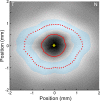The shape of the ganglion cell plus inner plexiform layers of the normal human macula
- PMID: 23033389
- PMCID: PMC3484734
- DOI: 10.1167/iovs.12-10515
The shape of the ganglion cell plus inner plexiform layers of the normal human macula
Abstract
Purpose: To use surfaces generated by two-dimensional penalized splines (2D P-splines) to characterize the shape of the macular ganglion cell plus inner plexiform layers (GCL+IPL) in a group of normal humans.
Methods: Macular images of the right eyes of 23 normal subjects ranging in age from 18 to 75 years were obtained with spectral-domain optical coherence tomography (SD-OCT). The thickness of GCL+IPL was determined by manual segmentation, areas with blood vessels were removed, and the resulting maps were fit by smooth surfaces in polar coordinates centered on the fovea.
Results: Smooth surfaces based on 2D P-splines could precisely represent GCL+IPL thickness data, with errors comparable to the axial resolution of the SD-OCT instrument. Metrics were developed for the size, shape, and slope of the edge of the foveal depression and size and shape of the surrounding macular ridge. The slope of the foveal edge was negatively correlated with foveal size (r = -0.60). The size of the macular ridge was positively correlated with foveal size (r = 0.75), with a slope near unity (0.90 ± 0.18). The centroids of the foveal edge and macular ridge clustered near the foveal center. The foveal edge and macular ridge were well fit by ellipses. The mean GCL+IPL thickness formed an elliptical annulus elongated by approximately 30% in the horizontal direction.
Conclusions: The methods developed here provide precise characterization of retinal layers for the study of glaucoma, foveal development, and other applications.
Conflict of interest statement
Disclosure:
Figures












References
-
- Springer AD, Hendrickson AE. Development of the primate area of high acuity. 1. Use of finite-element analysis models to identify mechanical variables affecting pit formation. Vis Neurosci. 2004;21:53–62 - PubMed
-
- Springer AD, Hendrickson AE. Development of the primate area of high acuity. 2. Quantitative morphological changes associated with retina and pars plana growth. Vis Neurosci. 2004;21:775–790 - PubMed
-
- Springer AD, Hendrickson AE. Development of the primate area of high acuity. 3. Temporal relationships between pit formation, retinal elongation and cone packing. Vis Neurosci. 2005;22:171–185 - PubMed
Publication types
MeSH terms
Grants and funding
LinkOut - more resources
Full Text Sources

